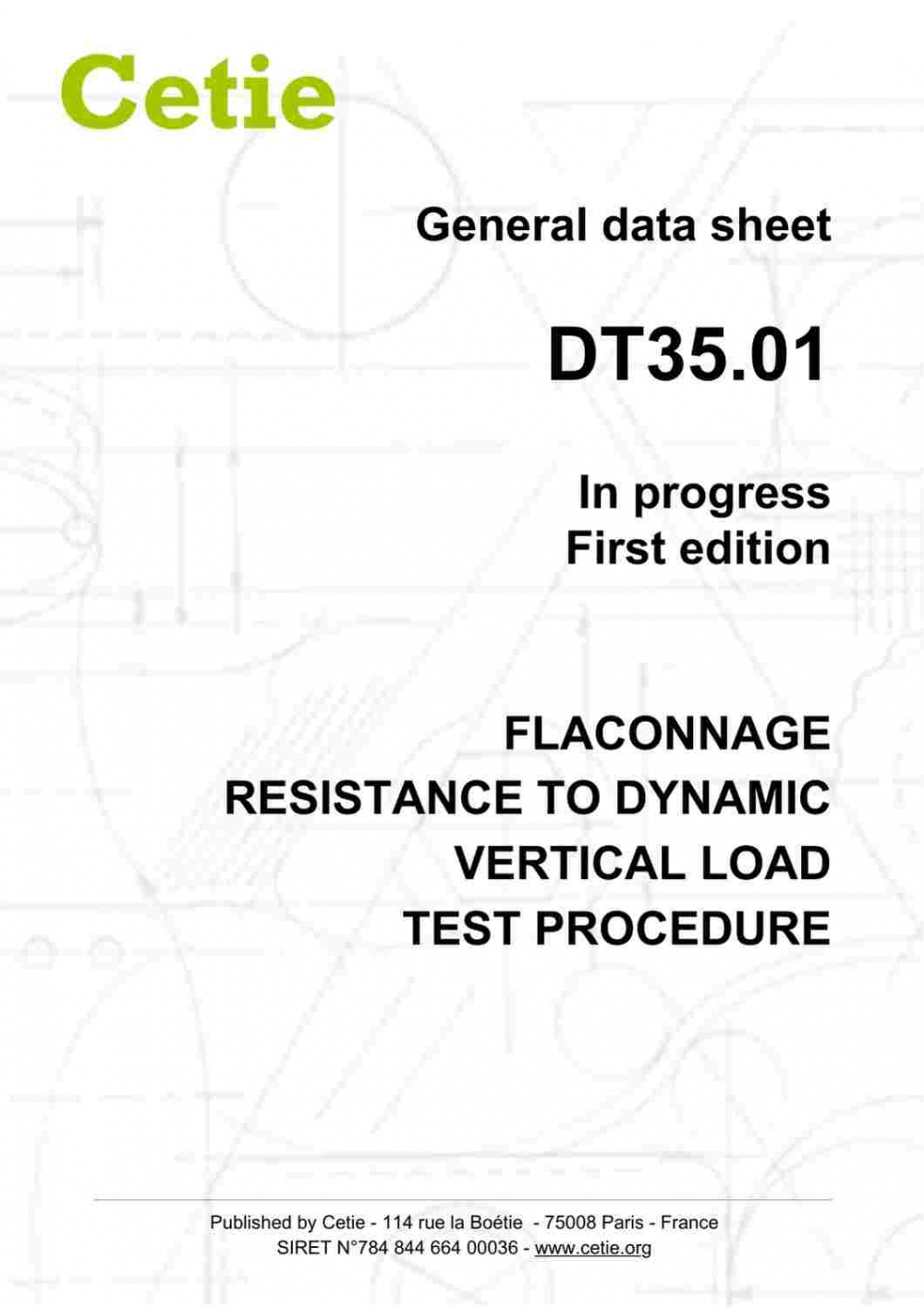DT35.01
First edition
Under development
Flaconnage - Resistance to dynamic vertical load - Test procedure
Scope of application
The aim of this test is to check how an article resists to vertical compression or snapping for an assembly.
The principle is to apply a vertical force to the tested element, using a cylinder that can be adjusted to conditions simulating as much as possible those used in industry.
This test applies to all types of articles that resist vertical and axial forces, in particular during the packaging phase (flacons, jars, glass, or plastic containers, for example).
The principle is to apply a vertical force to the tested element, using a cylinder that can be adjusted to conditions simulating as much as possible those used in industry.
This test applies to all types of articles that resist vertical and axial forces, in particular during the packaging phase (flacons, jars, glass, or plastic containers, for example).
Table of contents
1. Champ d’application
2. Equipement
3. Procédure
3.1. Principe
3.2. Méthodologie du test
3.3. Résultats
4. Annexes
4.1. Annexe 1
4.2. Annexe 2
4.3. Annexe 3
2. Equipement
3. Procédure
3.1. Principe
3.2. Méthodologie du test
3.3. Résultats
4. Annexes
4.1. Annexe 1
4.2. Annexe 2
4.3. Annexe 3
5. Documents in reference
5.1. Standards
5.2. Cetie
5.3. Others
6. Data sheet history
5.1. Standards
5.2. Cetie
5.3. Others
6. Data sheet history
This data sheet is currently in drafting stage. For more information, contact us.
Contributors
AGI GLASPAC, ANFEVI, APTAR FRANCE, ARDAGH GLASS PACKAGING SOUTH AFRICA, AROL, BERLIN PACKAGING, BORMIOLI LUIGI, BUNDESVERBAND GLASINDUSTRIE, CHANEL PARFUMS BEAUTÉ, COSTER GROUP, COTY FRANCE S.A. (PARIS), ESTEE LAUDER COMPANIES, GERRESHEIMER BELGIUM, GERRESHEIMER GERMANY, HEINZ GLAS, L'OREAL, PARFUMS CHRISTIAN DIOR, POCHET DU COURVAL, SAVERGLASS, SGD PHARMA, SHISEIDO INTERNATIONAL, SILGAN DISPENSING SYSTEMS, STAZIONE SPERIMENTALE DEL VETRO, STAZIONE SPERIMENTALE DEL VETRO, STOELZLE MASNIERES PARFUMERIE, STOELZLE-OBERGLAS, VERESCENCE FRANCE
Document under responsibility of working group:
Flaconnage geometry
WG chair: Lorenzo PASQUALI - BORMIOLI LUIGI S.p.A.
This joint group aims to produce dedicated documentation on glass flacons for the cosmetics, perfume, and pharmacy sectors:
- Cetie 'GME'* neck finishes data sheets concerning glass crimping neck finishes (FEA), screw neck finishes, neck finishes for pumps and snap-on neck finishes, etc.
- All data sheets of the DT15 series, identifying tolerances and standard test methods applicable to molded glass flacons;
- Data sheets concerning critical visual defects of flacons, neck finishes nomenclature, etc.
- Guide of crimping recommendations.
*Initiated by the glass industry in the 1960s, the acronym 'GME' stands for 'Glass Manufacturing Experimental'. The idea was that Cetie, as an unofficial standards body, would only publish 'experimental' data sheets, before submitting these to the official standards bodies. At the same time, in the USA, the acronym 'GME' was also used. As the original meaning was lost over time, this nomenclature for Cetie's glass finishes documents has been, later on, applied to the PET finish data sheets.
Document under drafting stage
